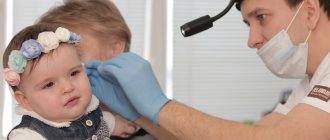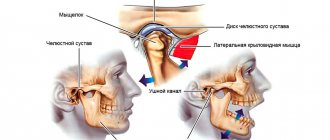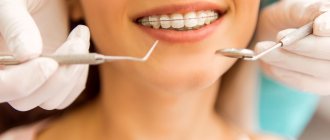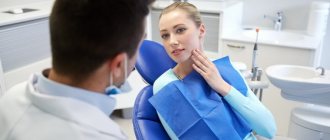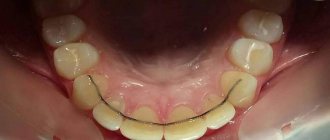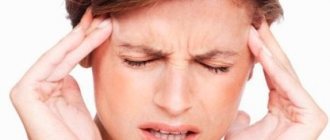What patients may complain about with diseases of the temporomandibular joint or TMJ
Clicking, crunching near the ear, namely in the projection of the temporomandibular joint (TMJ), pain in the jaw, jamming of the jaw when opening the mouth - all these are symptoms of muscular-articular dysfunction.
To find out the cause of this dysfunction, you first need to know how the joint works.
- Joint capsule
- Articular head or condyle
- Articular disc
- Articular tubercle
Where does everything come from?
Clicking is characteristic of dislocations of the articular disc, which can be anterior, posterior and lateral. The picture below shows from left to right: normal disc position, posterior dislocation, anterior dislocation. Dislocation occurs with or without reduction, i.e. with and without reduction. So, with a dislocation with reduction, you can hear two clicks: the first at the moment of opening the mouth, the second at the moment of closing.
What are the dangers of clicking in a joint? The danger lies in premature wear of the joint elements, which will lead to the development of arthritis, arthrosis and the final stage - ankylosis (complete immobility of the joint).
As for the crunching sound in the joint when the jaw moves, this sound is more characteristic of arthrosis of the TMJ. It occurs as a result of friction of deformed surfaces. The outcome of arthrosis is ankylosis or complete immobility of the joint.
Pain syndrome may often accompany TMJ arthritis, and in the projection of the joint, i.e. in front of the ear tragus there is swelling, skin hyperemia, general malaise, increased body temperature, etc. Arthritis pain is acute. Purulent inflammation in a joint can result in complete destruction of all its elements.
Also, acute pain can accompany neuralgia, anterior dislocation of the articular disc, in which the posterior condylar fusion ruptures and compression of the articular disc occurs. Dull, aching pain can occur with arthrosis, chronic arthritis and TMJ pain dysfunction syndrome (TMD).
With the development of BSD, in addition to pain in the joint area, headaches, pain and noise in the ears, and muscle tension in the occipital region are also possible.
Patients complain of difficulty opening the mouth (jaw contracture) mainly with arthrosis and sometimes with BSD. The process of jaw jamming is a different problem, and should not be confused with jaw contracture. The mechanism of wedging refers to the dislocation of the articular disc, which was discussed above. Without going into details, this can be explained this way: the articular head, under certain circumstances, does not return to its original position, because cannot overcome, for example, the posterior pole of the disc if it was in a state of dislocation. Or we are talking about dislocation of the lower jaw, when the articular head, when opening the mouth very wide, moves forward from the articular tubercle.
Distinctive features
Complaints in diseases of the TMJ should be distinguished from many other pathological processes in this area. So next to the TMJ there are: the auditory canal, the parotid salivary gland, the masticatory muscle, lymph nodes, and the corresponding pathological processes: otitis media, sialadenitis, myositis, lymphadenitis. In addition, pain can be due to neuralgia and inflammatory diseases in the skin and subcutaneous tissue (for example, with a boil). Separately, it is necessary to consider tumors of the parotid-masticatory region, benign and malignant.
As for the pathology of the oral cavity, in the form of difficult eruption of wisdom teeth or complicated dental caries, the main problem they create is limited opening of the mouth (contracture), which occurs as a result of the transfer of inflammation to the masticatory muscles. The pain in this case may also be similar, because impulses from the teeth spread along the branches of the trigeminal nerve, and the pain can radiate to the ear and temple.
Which doctor can help?
The dentist deals with this problem. The area of activity may be as follows: orthopedics, orthodontics or surgery; The main thing is that the doctor specializes in the diagnosis and treatment of TMJ pathology. Currently, such specialists are usually called gnathologists.
What if my dentist finds it difficult to make a diagnosis?
And this can happen. It is necessary to consult with related specialists: ENT doctor, neurologist, maxillofacial surgeon. If these specialists rule out their pathology, then there is only one option left. What's next? See previous paragraph.
What examination is necessary to diagnose TMJ pathology?
Unfortunately, based on complaints alone, a diagnosis cannot be made and, accordingly, treatment cannot be prescribed. An examination and sometimes additional studies are required: X-ray examination, computed tomography, electromyography, recording of movements of the lower jaw, etc.
Establishing the causes of the disease can be helped by collecting anamnesis: previous injury, any treatment (especially dental), the presence of diseases of internal organs and body systems, etc.
What can you do yourself?
If TMJ is still suspected, then the only thing you can do to help yourself is to create rest for the joint. That is, exclude solid foods, exclude chewing gum, do not open your mouth wide and do not yawn. If there is severe pain, when it is not possible to visit a doctor and there are no contraindications, use analgesics.
For complete treatment of TMJ diseases, see specialized literature.
Head and jaw hurt
According to doctors, pain in the head and jaw can occur simultaneously. Similar symptoms are caused by dental pathologies. Sometimes the problem can be caused by pathologies of the visual organs, blood vessels and ENT organs. The article will describe the reasons for this phenomenon.
- Malocclusion
Pain in the jaw and head can be caused by impaired jaw closure and the functioning of the masticatory muscles. Bite pathologies can lead to scoliosis.
- Caries in an advanced stage
Pain caused by inflammatory dental diseases (caries, pulpitis, granuloma) is felt in the jaw and the area of the affected unit. Initially, discomfort occurs due to temperature or mechanical influence. At an advanced stage, sharp pain occurs independently and radiates to adjacent areas.
- Edentia or damaged elements
With partial edentia, neighboring teeth and nearby muscles are subject to intense stress. The patient has to adapt and chew food on the healthy part of the jaw.
- Availability of orthodontic and orthopedic products
Pain may occur after placement of bite correction devices. This is a normal condition when the dentition gets used to a new position. Unpleasant sensations arise due to the pressure of the structure on the teeth. The discomfort goes away within a few weeks.
There should be no pain or discomfort during prosthetics. This indicates the low quality of treatment.
- Strong galvanic currents
The occurrence of galvanosis is due to the movement of galvanic currents in the mouth and their intense influence. The anomaly is typical for patients with metal prostheses in the mouth. The reaction occurs due to an allergy to metal alloys and non-compliance with production technology.
- Bruxism
An involuntary phenomenon at night. Manifested by excessive clenching of the jaw. People learn about pathology from their relatives. Patients experience fatigue and tension headaches in the morning. Teeth are brittle and have worn out enamel.
- Dental treatment
Patients note such negative phenomena immediately after treatment. Discomfort occurs after therapeutic manipulations and surgical interventions. This is due to stress, prolonged stay in a position with an open mouth, and the traumatic nature of the doctor’s actions.
- Erupting wisdom tooth
The third molar, as it passes through the jawbone, exerts pressure and irritates the nerve endings. The pain is blurred and spreads to the entire jaw, radiating to the temples and head.
It is worth going to the dentist and getting an x-ray. Third molars may be impacted or dystopic. Such elements provoke crowding of the jaw row, malocclusion, pericoronitis, accompanied by pain and discomfort.
- Complications after surgery
Surgical procedures are accompanied by pain, swelling and other manifestations. Gradually the unpleasant sensations subside. If acute pain remains 3-4 days after treatment, this indicates complications. Alveolitis develops - inflammation in the diseased socket. In the absence of timely treatment, there is a risk of developing flux, abscess and osteomyelitis.
Doctors are sure that pain in the head or jaw is sometimes mistaken for toothache.
- Subluxations and dislocations
Develop due to arthritis or joint disease. The problem can be caused by excessive opening of the mouth and displacement of the articular head of the lower jaw. Soreness is felt in the head, temples and cheeks.
- Trigeminal neuralgia
When the trigeminal nerve is damaged or inflamed, acute pain is felt like a migraine. The patient experiences discomfort in the jaw.
- Diseases of the ENT organs
Sinusitis, tonsillitis and other ENT diseases are disguised as dental problems. Otitis media provokes intense pain in the head and jaw. Identical symptoms are characterized by sinusitis and sinusitis. This is due to the close location of organs and the spread of pathogens through the bloodstream.
- Cluster headache
Characterized by pain in the upper jaw area. Acute pain is mistakenly mistaken for manifestations of pulp inflammation or periodontitis.
- Viral, infectious diseases, hypothermia
Hypothermia or ARVI can provoke a migraine. Associated symptoms characteristic of infectious diseases occur: hyperthermia, rhinitis, cough.
- Angina pectoris
Discomfort in the heart can shoot into the arm or shoulder on the left side of the body. Occasionally, pain is felt in the head or lower jaw.
Only a doctor can determine the cause of a headache and choose the right treatment. If symptoms occur, you should contact your dentist.
TMJ dysfunction - symptoms and treatment
There is no single, universal method for treating TMJ dysfunctions. Full treatment may be hindered by pain that does not allow the necessary therapeutic measures to be carried out.
Conservative therapy allows you to relieve acute manifestations of pathology, ensures the weakening or complete disappearance of symptoms and restores the function of the lower jaw in full.
Physiotherapy is effective in reducing pain. To reduce pain, fluctuarization is used in the TMJ area. The essence of the procedure is the use of alternating, partially or fully rectified low-voltage electric current with a chaotically varying oscillation frequency. Fluctuarization helps reduce pain after 2-3 sessions. If the myogenic nature of the pain is caused by myositis (inflammatory damage to the skeletal muscles) due to contact involvement of the muscle in the inflammatory process, then treatment should first of all be aimed at eliminating the cause of the inflammation.
Amplipulse therapy (sinusoidal modulated current therapy) has shown effectiveness in the treatment of myofascial syndrome (a chronic condition in which pain points form in muscle tissue), reducing the tone of spastically contracted muscles.
Pain of joint origin is treated by prescribing phonophoresis with hydrocortisone, which allows to relieve pain in the acute period and reduce inflammation.
All types of treatment must be carried out under the control of electromyography to assess the effectiveness, equalize and normalize the electrical potentials of the muscles.
During complex treatment, the patient himself must perform myogymnastics after proper training in the technique. It includes passive and active exercises for the moving muscles of the lower jaw and neck muscles. Passive exercises are carried out without load; the patient needs to perform various movements of the lower jaw. Active exercises also include various movements of the lower jaw, but with a load (the patient’s arms counteract the movement being performed) [3]. Exercises should be done 3 times a day for 10-15 minutes.
To normalize bite and occlusal disorders, special orthopedic treatment methods are used - correction of occlusion and the use of orthopedic structures (splints, mouth guards, bite blocks, myostimulation, etc.).
Surgical treatment methods are used for serious morphological pathological changes in the joint. The main indication for surgical treatment is anterior displacement of the intraarticular disc.
Surgical treatment consists of focal chondroplasty of the disc or head of the lower jaw using autologous cartilage (usually nasal cartilage). It is also possible to reduce the disc and suturing the stretched intra-articular ligaments and joint capsule. These methods are aggressive for a complex articular system and they do not always give good results [11].
In the complex issue of treating TMJ dysfunction, over time, the most effective scheme has proven to be the use of medication, manual therapy, physiotherapy and orthopedic treatment aimed at restoring the dentition and normalizing the bite.
